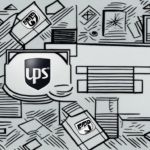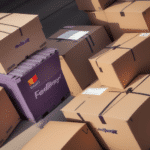Why It's Important to Insure Your Package When Shipping with FedEx
Shipping packages can be a risky process, especially if they contain valuable items or confidential information. By insuring your package, you protect yourself from unpredictable events that may occur during transit, such as theft, damage, or loss. According to the International Parcel Loss Statistics, a significant percentage of packages experience some form of loss or damage each year. FedEx offers insurance to provide peace of mind and ensure that your packages are fully protected during shipping.
One of the benefits of insuring your package with FedEx is the ability to easily track your shipment and receive updates on its status. This allows you to stay informed and take immediate action if any issues arise during transit. Additionally, FedEx offers a variety of insurance options to fit your specific needs and budget, enabling you to choose the level of coverage that works best for you.
Insuring your package can also help you avoid potential financial losses. If your package is lost, damaged, or stolen during transit and you don't have insurance, you may be responsible for covering the cost of the lost or damaged items. By insuring your package, you can avoid these unexpected expenses and ensure that you are fully reimbursed for any losses that occur.
Understanding the Different Insurance Options Available on FedEx Ship Manager
FedEx offers several insurance options to their customers, each designed to meet different needs:
- Declared Value: Protects your package up to the amount you declare its value.
- FedEx Transport Insurance: Provides full coverage for your package during shipping.
- Third-Party Insurance: Allows you to use an external insurance provider to cover your package.
Understanding the differences between these options is crucial to choosing the one that best suits your needs. The cost of each insurance option varies based on the declared value of your package and the shipping destination. Additionally, certain items may not be eligible for specific insurance options, such as hazardous materials or perishable goods. Before selecting an insurance option, review the FedEx insurance terms and conditions to ensure that your package is fully covered and that you understand any limitations or exclusions.
How to Determine the Value of Your Package for Insurance Purposes
Accurately determining the value of your package is essential when insuring it. The value should encompass the total cost of the items being shipped plus any additional expenses, such as shipping and handling fees. If you're uncertain about the value of your package, consider seeking an appraisal from a qualified professional. Accurate valuation ensures that you purchase the correct amount of insurance coverage, providing adequate protection.
For items that may appreciate in value over time, such as antiques or collectibles, periodic appraisals are recommended to ensure that your insurance coverage reflects their current market value. Additionally, if you've made significant upgrades or modifications to an item, include those costs when determining its value for insurance purposes.
Step-by-Step Guide on How to Purchase Insurance for Your Package on FedEx Ship Manager
Purchasing insurance for your package on FedEx Ship Manager is straightforward. Follow these steps:
- Log in to your account on FedEx Ship Manager.
- Select the package you want to insure.
- Choose the insurance option that best suits your needs and budget.
- Declare the value of your package.
- Complete the payment process.
It's important to note that FedEx offers insurance coverage up to $100 for free. For packages valued higher than this, additional insurance must be purchased. Carefully consider the value of your package and the potential risks involved in shipping it before selecting an insurance option.
Tips for Choosing the Right Amount of Insurance Coverage for Your Shipment
When selecting insurance coverage for your shipment, consider the following factors:
- Total Value: Ensure that the coverage amount matches or exceeds the total value of your package.
- Risk Assessment: Evaluate the risks based on the mode of transportation. For example, air transport is generally safer than ground, but may be more expensive to insure.
- Policy Details: Read the insurance policy carefully to understand coverage limits and exclusions. Some policies may not cover certain types of damage or loss, such as those caused by natural disasters or theft.
Choosing the appropriate coverage ensures that your package is protected against the specific risks it may encounter during transit.
What to Do If You Need to Make a Claim for Damaged or Lost Packages
If your package is damaged or lost during transit, you can file a claim with FedEx. Follow these steps to file a claim:
- Gather and provide proof of the package’s value and documentation of the damage or loss.
- File the claim as soon as possible to avoid delays. Claims can typically be filed online through the FedEx claims center.
- FedEx will investigate the claim and compensate you appropriately based on the coverage selected.
Be aware that certain items, such as cash, jewelry, and antiques, may not be fully covered under standard shipping insurance. For these items, consider purchasing additional insurance to ensure adequate protection. Additionally, proper packaging is crucial to prevent damage during transit. Use sturdy boxes and appropriate cushioning materials like bubble wrap and packing peanuts to protect your package.
Common Mistakes to Avoid When Insuring Packages with FedEx Ship Manager
Avoiding common mistakes can ensure that your package is fully protected during shipping:
- Incorrect Valuation: Declaring the wrong value of your package can result in insufficient coverage. Accurately determine and declare the full value of your items.
- Insufficient Coverage: Failing to purchase enough insurance can leave you financially vulnerable. Ensure that your coverage matches the total value of your package.
- Ignoring Policy Details: Not reviewing the insurance policy can lead to unexpected exclusions. Always read and understand the terms and conditions of your insurance policy.
By avoiding these common mistakes, you can ensure that your package is adequately protected against potential risks during shipping.
Conclusion
Insuring your package when shipping with FedEx is a smart decision to protect against unpredictable events during transit. By understanding the different insurance options available, accurately determining the value of your package, purchasing appropriate insurance coverage, and avoiding common mistakes, you can ensure that your package is fully protected during shipping.
Remember that certain items may have limited or no coverage under standard insurance policies. Before shipping high-value items like cash, jewelry, or antiques, check with FedEx to determine the extent of coverage available or consider purchasing additional insurance. Proper packaging and diligent tracking of your shipment further enhance the safety and security of your package.
For more information on FedEx shipping insurance and to manage your shipments effectively, visit the FedEx Insurance Information page.






















